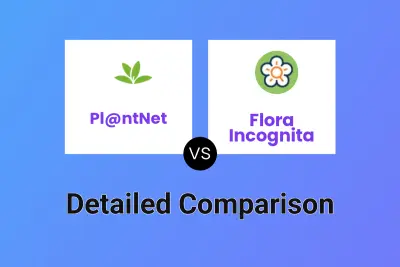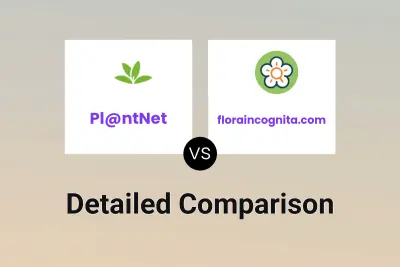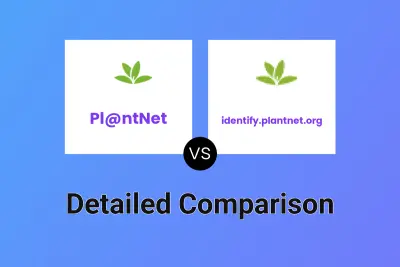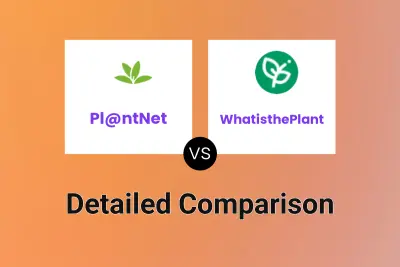 Pl@ntNet
VS
Pl@ntNet
VS
 identify.plantnet.org
identify.plantnet.org
Pl@ntNet
Pl@ntNet is an innovative citizen science platform that combines artificial intelligence with community participation to help users identify plants through photographs. The application leverages advanced image recognition technology to analyze plant photos and provide accurate species identification.
The platform serves as both a practical tool for plant identification and a valuable scientific resource, contributing to botanical research and biodiversity documentation worldwide. With over 51,000 species and more than 1 billion images in its database, Pl@ntNet has established itself as a leading collaborative platform for plant identification and botanical knowledge sharing.
identify.plantnet.org
Pl@ntNet serves as a valuable resource for identifying various plant species through image analysis. It operates by comparing user-submitted photos against extensive databases, organized into specific thematic and geographical floras. Users can select a flora relevant to their region or interest, such as 'World flora' for broad coverage, or more specialized floras like 'Useful plants', 'Weeds', or regional options for increased accuracy.
The platform encourages user participation by allowing individuals to contribute their own plant observations, thereby enriching the collective knowledge base. It features regularly updated lists of recently observed species and contributions from the community. Pl@ntNet supports a wide range of floras, covering numerous global regions from Europe and Africa to Asia, the Americas, and Australasia, including specific microprojects and thematic collections like ornamental trees or invasive species.
Pricing
Pl@ntNet Pricing
Pl@ntNet offers Free pricing .
identify.plantnet.org Pricing
identify.plantnet.org offers Free pricing .
Features
Pl@ntNet
- AI-Powered Recognition: Advanced image analysis for plant identification
- Offline Mode: Identify plants without internet connection
- Global Flora Coverage: Access to worldwide plant species database
- Collaborative Platform: Community-driven data validation and contribution
- Citizen Science Integration: Direct contribution to botanical research
- Group Functionality: Collaborative learning and sharing features
identify.plantnet.org
- Plant Identification via Image Upload: Users can upload or provide a URL for a plant image to receive identification suggestions.
- Thematic and Geographical Floras: Organizes plant databases by themes (useful plants, weeds, invasive species) and geographical regions (continents, specific areas like national parks).
- Community Contributions: Allows users to upload their own observations and images, contributing to the database.
- Species Exploration: Users can browse species within specific floras and view contributed images.
- Wide Flora Coverage: Includes numerous regional floras spanning Europe, Africa, Asia, Americas, Australasia, and specific microprojects.
Use Cases
Pl@ntNet Use Cases
- Plant species identification in the field
- Botanical research and documentation
- Educational activities and teaching
- Biodiversity monitoring
- Environmental conservation projects
- Personal garden plant identification
identify.plantnet.org Use Cases
- Identifying unknown plants encountered in the wild or gardens.
- Learning about local flora in a specific geographical region.
- Contributing to citizen science projects related to botany.
- Researching specific plant types like weeds, useful plants, or invasive species.
- Exploring plant diversity across different continents and ecosystems.
FAQs
Pl@ntNet FAQs
-
Can I use Pl@ntNet without an internet connection?
Yes, Pl@ntNet offers an offline mode that allows you to identify plants without internet connectivity. -
How many plant species can Pl@ntNet identify?
Pl@ntNet can identify over 51,000 plant species from its database. -
How can I contribute to the Pl@ntNet project?
You can contribute by sharing plant photos, participating in collaborative revision, creating an account, and supporting the project through donations.
identify.plantnet.org FAQs
-
How does Pl@ntNet identify plants?
Pl@ntNet identifies plants by comparing pictures you submit against its extensive database of plant images, using visual recognition technology. -
What are floras in Pl@ntNet?
Floras are collections of plant species organized by specific themes (like useful plants or weeds) or geographical regions (like Europe or Tropical Africa). Choosing a relevant flora can improve identification accuracy. -
Can I contribute to Pl@ntNet?
Yes, users can contribute by uploading their own observations and pictures of wild plants, helping to expand the database. -
What if I don't know which flora to choose?
If you are unsure which flora to select, you can choose the 'World flora' option, which offers the widest coverage, although it might be less precise than a more specific flora.
Uptime Monitor
Uptime Monitor
Average Uptime
100%
Average Response Time
872.8 ms
Last 30 Days
Uptime Monitor
Average Uptime
99.93%
Average Response Time
1994.13 ms
Last 30 Days
Pl@ntNet
identify.plantnet.org
More Comparisons:
-

Pl@ntNet vs PictureThis Detailed comparison features, price
ComparisonView details → -

Pl@ntNet vs Flora Incognita Detailed comparison features, price
ComparisonView details → -

Pl@ntNet vs floraincognita.com Detailed comparison features, price
ComparisonView details → -

Pl@ntNet vs identify.plantnet.org Detailed comparison features, price
ComparisonView details → -

Pl@ntNet vs WhatisthePlant Detailed comparison features, price
ComparisonView details → -

Pl@ntNet vs Plantility Detailed comparison features, price
ComparisonView details →
Didn't find tool you were looking for?